Holy Lovenia
Crowdsource, Crawl, or Generate? Creating SEA-VL, a Multicultural Vision-Language Dataset for Southeast Asia
Mar 10, 2025Abstract:Southeast Asia (SEA) is a region of extraordinary linguistic and cultural diversity, yet it remains significantly underrepresented in vision-language (VL) research. This often results in artificial intelligence (AI) models that fail to capture SEA cultural nuances. To fill this gap, we present SEA-VL, an open-source initiative dedicated to developing high-quality, culturally relevant data for SEA languages. By involving contributors from SEA countries, SEA-VL aims to ensure better cultural relevance and diversity, fostering greater inclusivity of underrepresented languages in VL research. Beyond crowdsourcing, our initiative goes one step further in the exploration of the automatic collection of culturally relevant images through crawling and image generation. First, we find that image crawling achieves approximately ~85% cultural relevance while being more cost- and time-efficient than crowdsourcing. Second, despite the substantial progress in generative vision models, synthetic images remain unreliable in accurately reflecting SEA cultures. The generated images often fail to reflect the nuanced traditions and cultural contexts of the region. Collectively, we gather 1.28M SEA culturally-relevant images, more than 50 times larger than other existing datasets. Through SEA-VL, we aim to bridge the representation gap in SEA, fostering the development of more inclusive AI systems that authentically represent diverse cultures across SEA.
Thank You, Stingray: Multilingual Large Language Models Can Not (Yet) Disambiguate Cross-Lingual Word Sense
Oct 28, 2024



Abstract:Multilingual large language models (LLMs) have gained prominence, but concerns arise regarding their reliability beyond English. This study addresses the gap in cross-lingual semantic evaluation by introducing a novel benchmark for cross-lingual sense disambiguation, StingrayBench. In this paper, we demonstrate using false friends -- words that are orthographically similar but have completely different meanings in two languages -- as a possible approach to pinpoint the limitation of cross-lingual sense disambiguation in LLMs. We collect false friends in four language pairs, namely Indonesian-Malay, Indonesian-Tagalog, Chinese-Japanese, and English-German; and challenge LLMs to distinguish the use of them in context. In our analysis of various models, we observe they tend to be biased toward higher-resource languages. We also propose new metrics for quantifying the cross-lingual sense bias and comprehension based on our benchmark. Our work contributes to developing more diverse and inclusive language modeling, promoting fairer access for the wider multilingual community.
WorldCuisines: A Massive-Scale Benchmark for Multilingual and Multicultural Visual Question Answering on Global Cuisines
Oct 16, 2024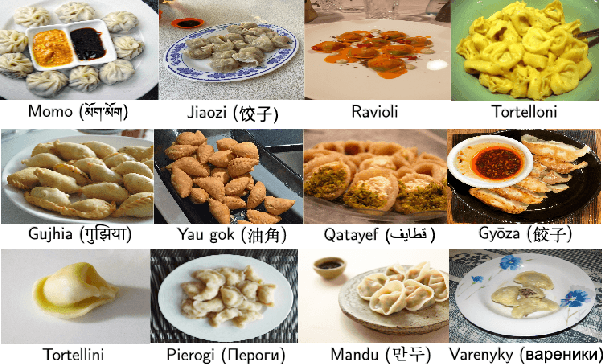

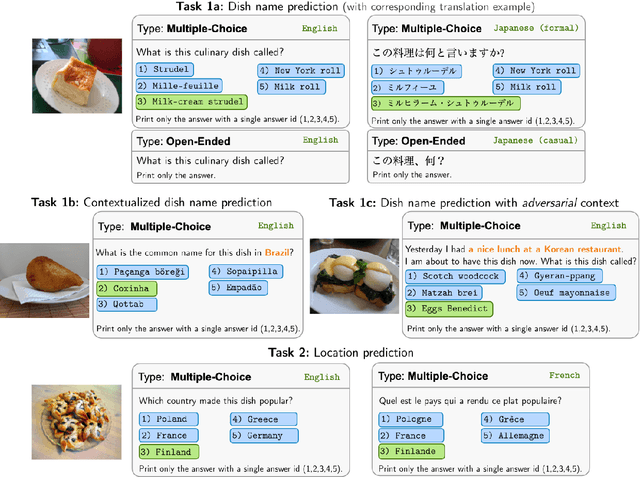

Abstract:Vision Language Models (VLMs) often struggle with culture-specific knowledge, particularly in languages other than English and in underrepresented cultural contexts. To evaluate their understanding of such knowledge, we introduce WorldCuisines, a massive-scale benchmark for multilingual and multicultural, visually grounded language understanding. This benchmark includes a visual question answering (VQA) dataset with text-image pairs across 30 languages and dialects, spanning 9 language families and featuring over 1 million data points, making it the largest multicultural VQA benchmark to date. It includes tasks for identifying dish names and their origins. We provide evaluation datasets in two sizes (12k and 60k instances) alongside a training dataset (1 million instances). Our findings show that while VLMs perform better with correct location context, they struggle with adversarial contexts and predicting specific regional cuisines and languages. To support future research, we release a knowledge base with annotated food entries and images along with the VQA data.
SEACrowd: A Multilingual Multimodal Data Hub and Benchmark Suite for Southeast Asian Languages
Jun 14, 2024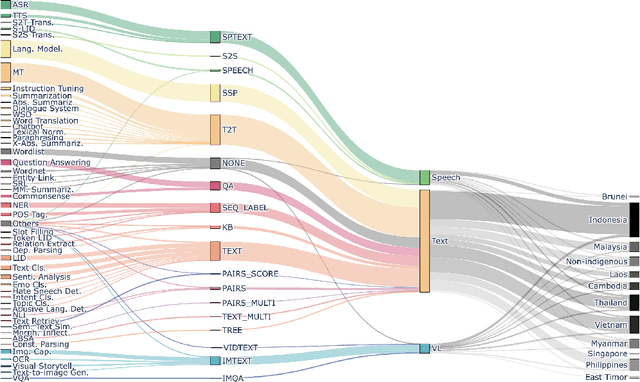
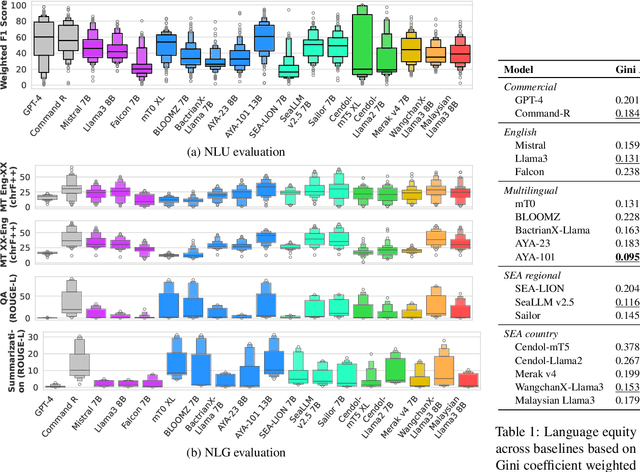
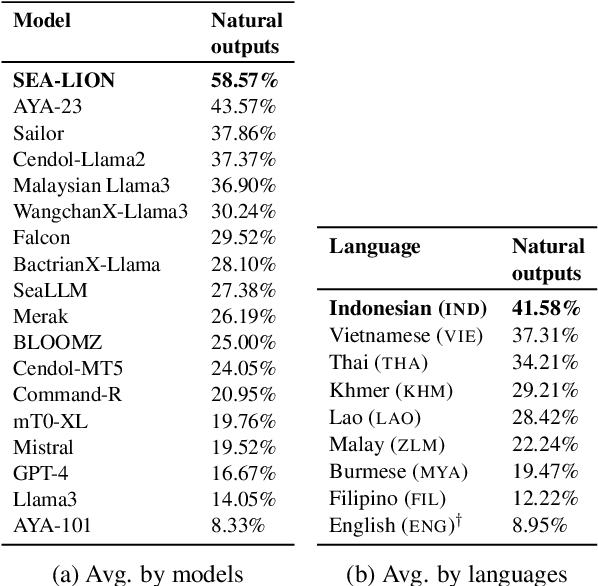
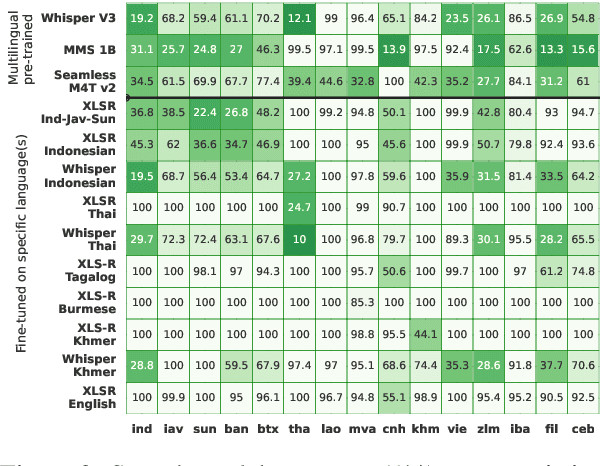
Abstract:Southeast Asia (SEA) is a region rich in linguistic diversity and cultural variety, with over 1,300 indigenous languages and a population of 671 million people. However, prevailing AI models suffer from a significant lack of representation of texts, images, and audio datasets from SEA, compromising the quality of AI models for SEA languages. Evaluating models for SEA languages is challenging due to the scarcity of high-quality datasets, compounded by the dominance of English training data, raising concerns about potential cultural misrepresentation. To address these challenges, we introduce SEACrowd, a collaborative initiative that consolidates a comprehensive resource hub that fills the resource gap by providing standardized corpora in nearly 1,000 SEA languages across three modalities. Through our SEACrowd benchmarks, we assess the quality of AI models on 36 indigenous languages across 13 tasks, offering valuable insights into the current AI landscape in SEA. Furthermore, we propose strategies to facilitate greater AI advancements, maximizing potential utility and resource equity for the future of AI in SEA.
CVQA: Culturally-diverse Multilingual Visual Question Answering Benchmark
Jun 10, 2024



Abstract:Visual Question Answering (VQA) is an important task in multimodal AI, and it is often used to test the ability of vision-language models to understand and reason on knowledge present in both visual and textual data. However, most of the current VQA models use datasets that are primarily focused on English and a few major world languages, with images that are typically Western-centric. While recent efforts have tried to increase the number of languages covered on VQA datasets, they still lack diversity in low-resource languages. More importantly, although these datasets often extend their linguistic range via translation or some other approaches, they usually keep images the same, resulting in narrow cultural representation. To address these limitations, we construct CVQA, a new Culturally-diverse multilingual Visual Question Answering benchmark, designed to cover a rich set of languages and cultures, where we engage native speakers and cultural experts in the data collection process. As a result, CVQA includes culturally-driven images and questions from across 28 countries on four continents, covering 26 languages with 11 scripts, providing a total of 9k questions. We then benchmark several Multimodal Large Language Models (MLLMs) on CVQA, and show that the dataset is challenging for the current state-of-the-art models. This benchmark can serve as a probing evaluation suite for assessing the cultural capability and bias of multimodal models and hopefully encourage more research efforts toward increasing cultural awareness and linguistic diversity in this field.
Cendol: Open Instruction-tuned Generative Large Language Models for Indonesian Languages
Apr 09, 2024



Abstract:Large language models (LLMs) show remarkable human-like capability in various domains and languages. However, a notable quality gap arises in low-resource languages, e.g., Indonesian indigenous languages, rendering them ineffective and inefficient in such linguistic contexts. To bridge this quality gap, we introduce Cendol, a collection of Indonesian LLMs encompassing both decoder-only and encoder-decoder architectures across a range of model sizes. We highlight Cendol's effectiveness across a diverse array of tasks, attaining 20% improvement, and demonstrate its capability to generalize to unseen tasks and indigenous languages of Indonesia. Furthermore, Cendol models showcase improved human favorability despite their limitations in capturing indigenous knowledge and cultural values in Indonesia. In addition, we discuss the shortcomings of parameter-efficient tunings, such as LoRA, for language adaptation. Alternatively, we propose the usage of vocabulary adaptation to enhance efficiency. Lastly, we evaluate the safety of Cendol and showcase that safety in pre-training in one language such as English is transferable to low-resource languages, such as Indonesian, even without RLHF and safety fine-tuning.
LLMs Are Few-Shot In-Context Low-Resource Language Learners
Mar 27, 2024



Abstract:In-context learning (ICL) empowers large language models (LLMs) to perform diverse tasks in underrepresented languages using only short in-context information, offering a crucial avenue for narrowing the gap between high-resource and low-resource languages. Nonetheless, there is only a handful of works explored ICL for low-resource languages with most of them focusing on relatively high-resource languages, such as French and Spanish. In this work, we extensively study ICL and its cross-lingual variation (X-ICL) on 25 low-resource and 7 relatively higher-resource languages. Our study not only assesses the effectiveness of ICL with LLMs in low-resource languages but also identifies the shortcomings of in-context label alignment, and introduces a more effective alternative: query alignment. Moreover, we provide valuable insights into various facets of ICL for low-resource languages. Our study concludes the significance of few-shot in-context information on enhancing the low-resource understanding quality of LLMs through semantically relevant information by closing the language gap in the target language and aligning the semantics between the targeted low-resource and the high-resource language that the model is proficient in. Our work highlights the importance of advancing ICL research, particularly for low-resource languages.
Contrastive Learning for Inference in Dialogue
Oct 19, 2023Abstract:Inference, especially those derived from inductive processes, is a crucial component in our conversation to complement the information implicitly or explicitly conveyed by a speaker. While recent large language models show remarkable advances in inference tasks, their performance in inductive reasoning, where not all information is present in the context, is far behind deductive reasoning. In this paper, we analyze the behavior of the models based on the task difficulty defined by the semantic information gap -- which distinguishes inductive and deductive reasoning (Johnson-Laird, 1988, 1993). Our analysis reveals that the disparity in information between dialogue contexts and desired inferences poses a significant challenge to the inductive inference process. To mitigate this information gap, we investigate a contrastive learning approach by feeding negative samples. Our experiments suggest negative samples help models understand what is wrong and improve their inference generations.
InstructTODS: Large Language Models for End-to-End Task-Oriented Dialogue Systems
Oct 13, 2023Abstract:Large language models (LLMs) have been used for diverse tasks in natural language processing (NLP), yet remain under-explored for task-oriented dialogue systems (TODS), especially for end-to-end TODS. We present InstructTODS, a novel off-the-shelf framework for zero-shot end-to-end task-oriented dialogue systems that can adapt to diverse domains without fine-tuning. By leveraging LLMs, InstructTODS generates a proxy belief state that seamlessly translates user intentions into dynamic queries for efficient interaction with any KB. Our extensive experiments demonstrate that InstructTODS achieves comparable performance to fully fine-tuned TODS in guiding dialogues to successful completion without prior knowledge or task-specific data. Furthermore, a rigorous human evaluation of end-to-end TODS shows that InstructTODS produces dialogue responses that notably outperform both the gold responses and the state-of-the-art TODS in terms of helpfulness, informativeness, and humanness. Moreover, the effectiveness of LLMs in TODS is further supported by our comprehensive evaluations on TODS subtasks: dialogue state tracking, intent classification, and response generation. Code and implementations could be found here https://github.com/WillyHC22/InstructTODS/
Negative Object Presence Evaluation (NOPE) to Measure Object Hallucination in Vision-Language Models
Oct 09, 2023Abstract:Object hallucination poses a significant challenge in vision-language (VL) models, often leading to the generation of nonsensical or unfaithful responses with non-existent objects. However, the absence of a general measurement for evaluating object hallucination in VL models has hindered our understanding and ability to mitigate this issue. In this work, we present NOPE (Negative Object Presence Evaluation), a novel benchmark designed to assess object hallucination in VL models through visual question answering (VQA). We propose a cost-effective and scalable approach utilizing large language models to generate 29.5k synthetic negative pronoun (NegP) data of high quality for NOPE. We extensively investigate the performance of 10 state-of-the-art VL models in discerning the non-existence of objects in visual questions, where the ground truth answers are denoted as NegP (e.g., "none"). Additionally, we evaluate their standard performance on visual questions on 9 other VQA datasets. Through our experiments, we demonstrate that no VL model is immune to the vulnerability of object hallucination, as all models achieve accuracy below 10\% on NegP. Furthermore, we uncover that lexically diverse visual questions, question types with large scopes, and scene-relevant objects capitalize the risk of object hallucination in VL models.
 Add to Chrome
Add to Chrome Add to Firefox
Add to Firefox Add to Edge
Add to Edge